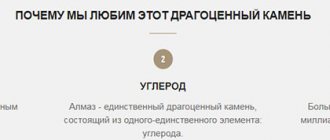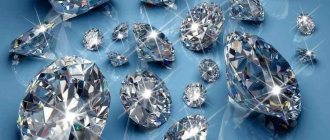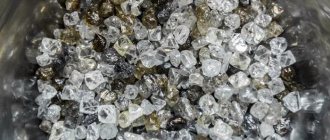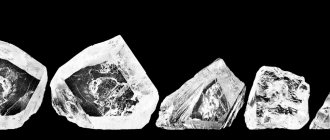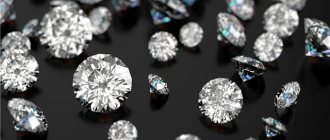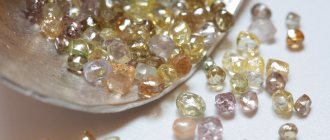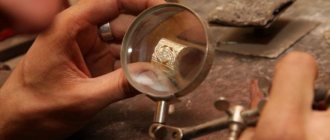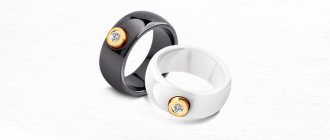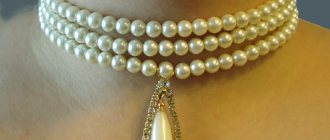When buying a diamond, everyone wants to be sure that they are giving their money for a stone of the highest quality. Should you only buy a certified diamond, or can you buy a non-certified one? Does the certificate guarantee the superiority of the stone in all respects?
The truth is that the certificate does not always indicate the impeccable quality of the stone. For example, you can buy a non-certified diamond that has a better color than a certified stone.
A certified diamond may have more inclusions (internal imperfections) than a non-certified diamond.
Of course you are confused. Let's look at how a certificate can be useful for you.
The essence of certification.
A diamond certificate indicates that the diamond has been evaluated by an independent third party to determine its characteristics and assign a grade.
This is a document that describes the most important qualitative characteristics of a certain stone.
It comes in report form and contains the diamond's characteristics as measured and evaluated by qualified gemologists.
Who issues diamond certificates?
These certificates are typically issued by grading laboratories, which are organizations that conduct scientific research and provide grading services to diamond dealers or individuals for a fee.
Here are some of the most reputable laboratories:
— GIA (Gemological Institute of America);
— AGS (American Gem Society);
— EGL (European Gemological Laboratory);
— CIBJO (Confederation International de la Bijouterie, Joaillerie, Orfevrerie des Diamants, Perles and Pierres; also known as the World Jewelry Confederation);
— IGI (International Gemological Institute).
The reports issued by these laboratories contain essentially the same information. However, they tend to differ in the level of detail as well as the weights used to assign grades (each laboratory uses different standards for evaluation).
Certified Sapphires, Rubies and Emeralds (GRS)
Colored gemstones such as sapphires, rubies and emeralds used in our products are also subject to certification. Such inserts are accompanied by GRS certificates.
GRS (Gem Research Swisslab) is a private Swiss Gemological Research Laboratory that specializes in determining the origin and authenticity of rubies, sapphires, emeralds and other multi-colored precious and semi-precious stones.
The Swiss laboratory GRS is engaged in a thorough study of multi-colored stones, natural and artificial, distinguished by color. It is equipped with the latest generation technology. Gems that were certified here took part in international jewelry exhibitions in countries such as France and Italy. The laboratory has representative offices in China, Thailand, the USA and Sri Lanka.
What information does a diamond certificate contain?
A diamond certificate (also known as a grading report) contains the most important information for determining the quality of a diamond.
The main quality characteristics that are taken into account during certification, the so-called diamond parameters, are clarity, color, carat and cut quality.
For example, the report will include a description of the color, cut, and clarity of the stone, along with the grades assigned to each of these characteristics.
The report will contain information about the diamond's exact carat weight, as well as the most important measurements of the stone that help determine how symmetrical it is.
One of the roles of a certificate is to provide third-party quality assurance. Therefore, it is very important for the qualification report to be issued by an independent organization that is not controlled by the supplier.
Dealers may tell you something about the quality of a particular diamond, but it goes without saying that they may be biased.
However, if the diamond is certified by a reputable grading laboratory, you can easily check how close to the truth the supplier's claims about the quality of the diamond are by examining its certificate.
This is why you should always buy certified diamonds - reading the document will tell you exactly what you are buying and will help you avoid overpaying for a stone that should be cheaper due to its quality.
How to bargain correctly when buying a diamond on the stock exchange
The buyer must have basic information about diamonds. Learn basic terms and characteristics. Be confident and do not ask: “What is the difference between the certificates?”, “What color of stone should I choose?” Such questions are a signal to the seller that you are not too “in the know.”
It is better to bargain with the store manager.
To avoid deception and get exactly the stone indicated on the certificate, you need to insist that the diamond be weighed in front of you. In addition, you can measure the parameters of the stone with an electronic caliper.
Pretend that you know about diamonds, even if you don't. Carefully examine the product with a magnifying glass for inclusions.
Difference between Diamond Certificate and Appraisal.
Diamond certification and grading are terms that are often confused. An appraisal is a document that expresses the monetary value of a diamond (or piece of jewelry); it is often used to determine how much you should pay for insurance.
A diamond certificate, on the other hand, does not value the stone in monetary terms; The purpose of this report is to document key quality characteristics without providing an opinion on how much a diamond should be worth.
It turns out that, despite certification, the diamond may be of low quality. Attestation simply ensures that it has passed an official assessment, that's all.
Certified diamonds are more expensive.
If there are no other differences between the two diamonds, the certified one will cost more. After all, certification costs money, and in a sense, you're paying to avoid being scammed.
Caveats about uncertified diamonds: An uncertified diamond does not mean a bad diamond. If you are satisfied with the price, color, clarity, weight and cut of the diamond, whether to buy it or not is up to you. However, if you are not experienced in diamond grading, purchasing uncertified stones can be dangerous.
Why are some diamonds not certified?
Many diamonds are not certified for a number of reasons:
- Certification costs money, and some sellers don't want to incur the additional expense.
- Sometimes jewelers think that it is not worth certifying low-quality diamonds because for such stones the grading report will not have much value to the buyer.
- And there are also sellers who prefer to offer non-certified diamonds so that they can present their quality in the most favorable light.
Certification is important to you as the buyer because it provides independent verification of the quality of the diamond.
World market structure
Once the diamonds are extracted from the ground, they are sorted into lots. Small stones are sold in lots ranging from several tens to several hundred thousand dollars, larger ones weighing over 5-10 carats - each separately at tenders or directly to affiliated polishing companies. By the way, the Russian word “cut” diamonds is considered not entirely correct and is replaced by “polish”.
$16.3 billion worth of rough diamonds mined in 2016 are turned into polished diamonds worth $25 billion and are sent through the hands and wallets of diamond dealers to jewelers. In jewelry boutiques, they get new life in jewelry worth $81 billion (data for 2016) due to duties, taxes and the appetite of jewelers. Half of this $41 billion worth of diamond jewelry is sold in the United States, another $10 billion in China, $6 billion in Japan, $4 billion in the Gulf, $3 billion in India and $17 billion in in the rest of the world
The diamond jewelry market is growing every year, in 2016 it increased, albeit slightly, by 0.3%.
Should you buy non-certified diamonds?
Without a certificate you can never be sure what you are buying. If a diamond is not certified, the only source of information about its quality characteristics is the seller, and it goes without saying that the seller's assessment is unlikely to be the most objective.
If a seller exaggerates the quality of a non-certified diamond, you may end up overpaying for a stone that would have been in the lower price range if certified.
Although diamond grading laboratories follow reliable guidelines when grading diamonds, the accurate assessment of any characteristic ultimately comes down to the judgment of the expert doing the grading.
Labs try to make this process as accurate as possible by requiring each diamond to be graded by multiple graders.
However, due to the inherent subjectivity of diamond grading, dealers may have some leeway in presenting the quality of a diamond to a customer. They are allowed to increase the grades of color and clarity of the stone, but not more than one step up from the assessment by an independent expert.
So, you should keep in mind that if you are buying a non-certified diamond, the jeweler may be giving you an optimistic estimate of its quality, and this may be perfectly legal.
If you want to make sure that the quality of the diamond you are buying is exactly what the jeweler claims, always ask for a certificate and do not buy uncertified stones.
Unless a diamond has a grading report, there is no way to know its exact quality. Differences between adjacent color scales, for example, can be so subtle that they are invisible to the naked eye.
However, they can have a big difference in price, especially if you are buying a non-graded diamond that has had its color increased by one grade.
Russian diamond disaster
No one knows what the size of the diamond market is in Russia. Alrosa polishes about 2% of the diamonds mined, which is no more than $100 million a year, some of it is polished by local small companies, there are also stones officially imported through customs, all together - about $400 million a year. No one can say how many diamonds are imported in a gray manner, but given that Russian clients are very popular in jewelry boutiques all over the world, there must be a lot.
Theoretically, 25% of the volume of raw materials mined in Russia should remain in Russia and be turned into diamonds by local cutters and sold in Russia. This is why there are special government orders aimed at developing cutting production in Russia. But in practice, all high-quality raw materials are sent to foreign tenders (Alrosa explains this by the lack of demand for diamonds in Russia), and the stones remaining in Russia are of low quality, of little interest to anyone and of insignificant value. We encountered this while studying diamonds at Gokhran tenders in Moscow: out of 600 auction lots, only the first ten positions could be called relatively high quality. A significant part of all the raw materials remaining for cutting in Russia ends up in the Gokhran storehouses, without being in demand.
Modern clients have an idea of how diamonds are valued - according to quality criteria: weight, color, clarity, cut in accordance with the Rappaport price list (a professional price list issued once a week for professional market participants). In Russia, amateurism and trust in jewelers are at approximately the same level—very high. The evaluation criterion is most often the price, and not the correspondence of the cost of a diamond to its quality. There are clients who sincerely believe that a 10-carat diamond can cost $100,000, despite the fact that this is actually 5-10 times less than the real price.
This attitude means there is a demand for deception, and demand creates supply. Diamonds sold in Russia are of low quality and expensive.
